Social Care Services, Scotland, 2017
Latest national figures for social care services provided or purchased by Local Authorities in Scotland.
This document is part of a collection
2. Social Care Summary Information
Age and gender
Figure 5 shows that most social care clients tend to be in older age groups and that the proportion of clients who are female increases with age. The 18-64 age group (covered in Section 4 of this report) is almost evenly split between male and female. For clients aged 65+, (covered in Section 3 of this report) 66% are female and 34% are male.
This may be due to many factors, including women's higher life expectancy and women being more likely to live alone as they get older. Figure 5 also shows that the 0-17 age group accounts for less than 2% of clients. Due to potential disclosure issues with small numbers there is no section focusing on 0-17 year olds in this report.
Figure 5: Age and gender of Social Care clients, 2017 1
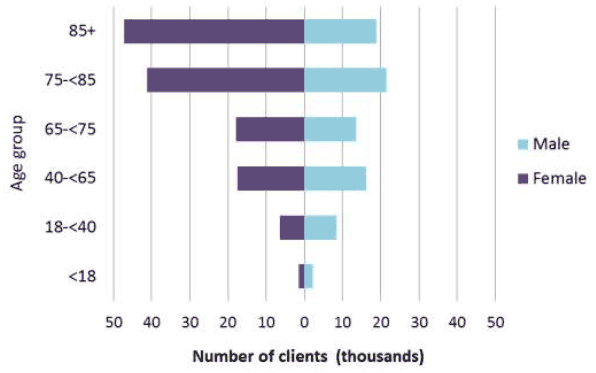
Note: Total of 212,220 clients. Gender information was unavailable for 4 clients under the age of 65.
1. 2017 Scotland figures are provisional as Angus council figures relate to 2016.
Source: Scottish Government Social Care Survey 2017
Ethnicity
Of all 2017 Social Care clients for whom ethnicity information was known, 98% were recorded as being "White", with 2% in other ethnic groups (Table 1).
Table 1: Ethnicity of Social Care clients, 2017
| Ethnic Group | Clients 1 | Percentage 2 |
|---|---|---|
| White | 150,000 | 98.1% |
| Other ethnicity | 2,950 | 1.9% |
¹ Ethnicity information was unavailable for 59,270 clients. 2017 Scotland figures are provisional as Angus council figures relate to 2016.
² Percentages are based on client figures rounded to the nearest ten and are given to nearest percentage point.
Source: Scottish Government Social Care Survey 2017
Living arrangements (Home Care clients aged 18+)
Home Care clients are more likely to be living alone as they get older: 55% of those aged 65+ were living alone, compared with 40% of those aged 18-64 (Figure 6).
Figure 6: Living arrangements of Home Care clients aged 18+*, 2017
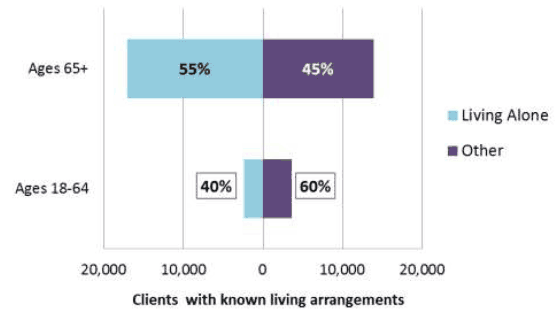
Based on 37,120 Home Care clients aged 18+. There were 22,520 cases with no data on Living Arrangements.
2017 Scotland figures are provisional as Angus council figures relate to 2016.
Source: Scottish Government Social Care Survey 2017
Client Group
Figure 7 shows the breakdown of Social Care clients by client group: the reason for needing a social care service. This shows that the largest groups are "Frail Older People" and "Physical Disability".
Figure 7: Client Group of clients receiving Social Care services, 2017
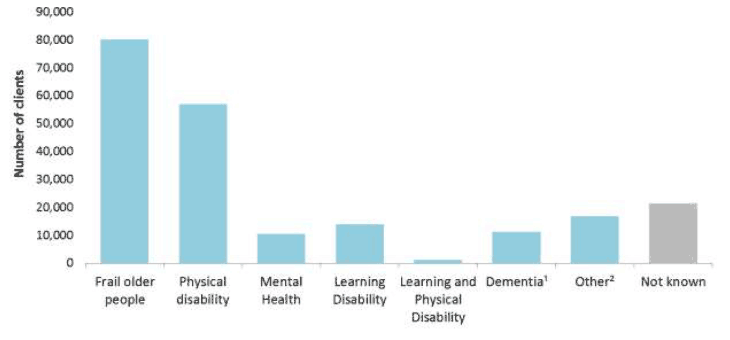
- Total of 212,220 clients
¹ Dementia is known to be under recorded in the social care management information system.
² Other includes addictions, palliative care and carers.
2017 Scotland figures are provisional as Angus council figures relate to 2016.
Source: Scottish Government Social Care Survey 2017
Figure 8 shows the breakdown of 2017 Social Care clients by age and client group. Almost all of the clients receiving a service due to being frail and elderly (100%) or due to dementia (98%) are aged 65 and over, while the majority of those receiving a service due to Mental Health (67%) or a Learning Disability (85%) are aged under 65.
Figure 8: Proportion of Social Care clients aged (a) under 65 and (b) 65+, by client group, 2017 1

1. 2017 Scotland figures are provisional as Angus council figures relate to 2016.
Source: Scottish Government Social Care Survey 2017
Home Care service provision
Over the past ten years Local Authorities have increasingly purchased Home Care from the private and voluntary sector, rather than providing services directly themselves. In March 2017, 47% of clients were receiving services provided solely by Local Authority staff (Figure 9). This proportion has been decreasing each year since 2008. The proportion of Home Care hours being provided by Local Authority staff was 30% in March 2017 and has again decreased every year since 2008. The difference between these proportions reflects the fact that the private and voluntary sectors, on average, provide larger packages of care.
Figure 9: Home Care provision by Service Provider, 2008 to 2017 1 (all ages)
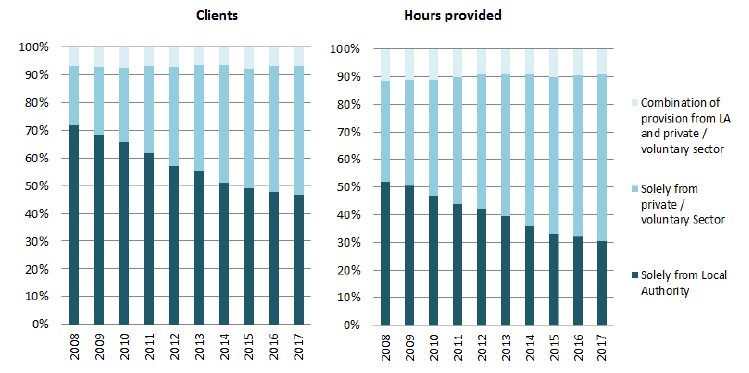
1. 2017 Scotland figures are provisional as Angus council figures relate to 2016.
Source: Scottish Government Social Care Survey 2013-2017, Home Care Census 2007-2012
Age breakdown for key services covered in this report
Figure 10 shows the age distribution of clients receiving different social care services. These services are mainly used by older people. However, over a third of people who receive Housing Support are aged under 65.
Figure 10: Key services by age, 2017 1

From 2013, Local Authorities were asked to class 24-7 care as Housing Support, not Home Care.
1. 2017 Scotland figures are provisional as Angus council figures relate to 2016.
Source: Scottish Government Social Care Survey 2017
Age breakdown for Self-directed Support options
Figure 11 shows the age breakdown of clients purchasing services through the different Self-Directed Support options (see background section 5.3 for more information on the different options available).
People purchasing services through option 3 (where services are arranged by the Local Authority) tend to be older whereas people purchasing services using Direct Payments (option 1) tend to be younger, with 16% of those choosing Direct Payments under the age of 18.
Figure 11: Self-directed Support clients, by age, 2017 1
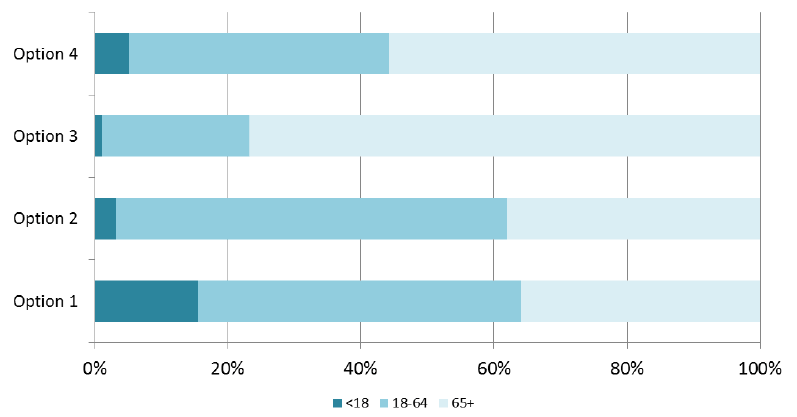
1. 2017 Scotland figures are provisional as Angus council figures relate to 2016.
Source: Scottish Government Social Care Survey 2017
Local Authority comparison: Rates per 1,000 population
Figure 12 gives an overview of how service provision varies across Scotland for Home Care while figure 13 gives an overview of the number of people using Direct Payments to purchase services across Scotland.
Note that while these charts enable comparisons to be made between Local Authorities, they should not be considered as a "ranking" as they will reflect the different demographics in each area and demand for services. There are several factors that can affect levels of recorded service provision, such as differing proportions of elderly people (who will be more likely to require Social Care services) and different levels of deprivation. Such variations are reflected in the funding formulae used to allocate resources to Local Authorities.
Figure 12: Clients receiving Home Care per 1,000 population, by Local Authority, 2017 1
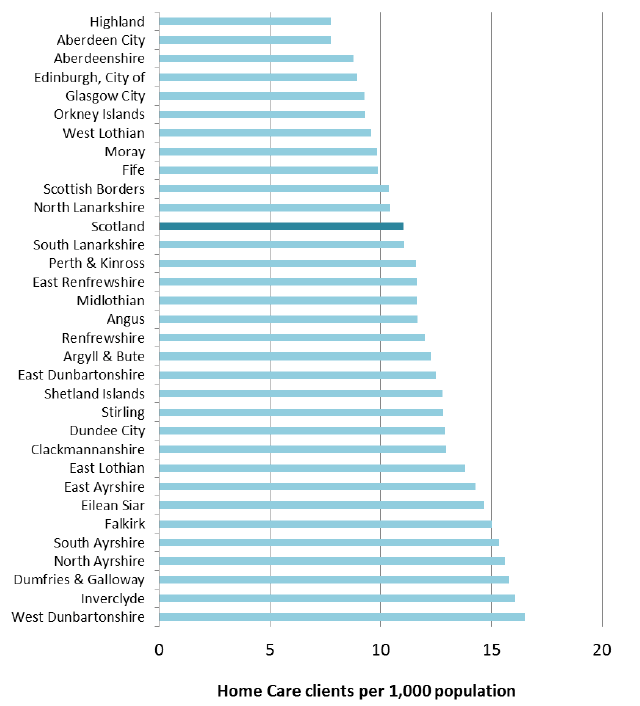
1. 2017 figures for Angus are provisional and relate to 2016. Figures are presented as rate per 1,000 population.
2. Adult Social Care in Highland is delivered by the Health board through a lead agency model.
Source: Scottish Government Social Care Survey 2017
Figure 13: Clients receiving Direct Payments per 1,000 population, by Local Authority, 2017 1
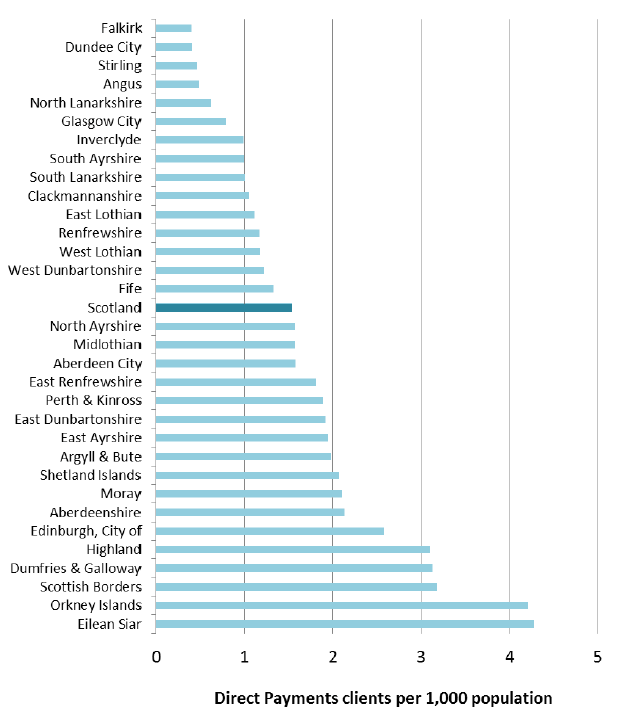
1. 2017 figures for Angus council are provisional and relate to 2016. Figures are presented as rate per 1,000 population.
2. Adult Social Care in Highland is delivered by the Health board through a lead agency model.
Source: Scottish Government Social Care Survey 2017
Meals Services
Data on Meals services provided at home has proved difficult for Local Authorities to capture, and as such the figures presented here; i) are likely to be lower than the true figures, and ii) should not be compared with previous years' figures to gauge changes in provision. There were 6,390 people recorded as receiving Meals services at the 2017 census. Figure 14 shows that most clients who received meals services were in the older age groups, while the majority (65%) received hot meals rather than frozen meals.
Figure 14: Clients receiving Hot or Frozen Meals¹, by age, 2017

¹ Some clients receive both hot and frozen meals.
² Three Local Authorities did not submit Meals data for 2017. Direct comparisons should not be made with previous years.
³ 2017 Scotland figures are provisional as Angus council figures relate to 2016.
Source: Scottish Government Social Care Survey 2017
Housing Support
Data on Housing Support was presented for the first time in 2015. Housing Support includes services such as assistance with claiming welfare benefits, filling in forms, managing budgets and help with shopping and housework. In previous years there has been some overlap in the definitions of Housing Support and Home Care used in recording by some Local Authorities; from 2013 Local Authorities were asked to record Live-in and 24/7 services as Housing Support and not Home Care. Note that around 82% of Housing Support clients were recorded as also receiving another Social Care service, while for 15 Local Authorities this figure was 100%. This suggests that there are likely to be other Housing Support clients who are not captured in the survey.
There were 18,940 people recorded as receiving Housing Support in 2017, a 10% decrease since last year. This is just under a third of the number who receive Home Care (59,640). While Home Care is provided mainly for older people, Housing Support tends to be split more evenly between older people and under 65s (Figure 15). Note that there is some overlap between the two categories: just over one third of Housing Support clients (35%) also received Home Care.
Figure 15: Number of clients receiving Housing Support¹ and Home Care, by age, 2017
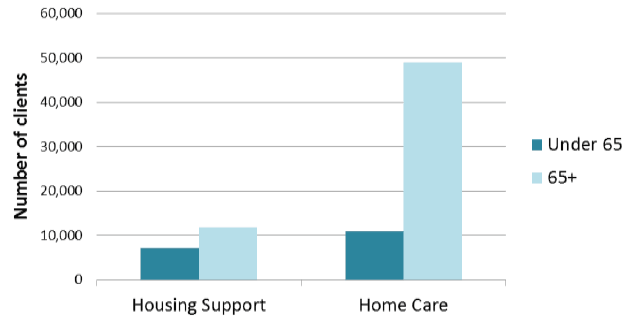
¹ 35% of Housing Support clients also received Home Care.
² 82% of Housing Support clients were recorded as also receiving another Social Care service, while for 15 Local Authorities this figure was 100%. This suggests there may be extra Housing Support clients not captured in the survey.
³ 2017 Scotland figures are provisional as Angus council figures relate to 2016.
Source: Scottish Government Social Care Survey 2017
The remainder of this report looks in more detail at the provision of Home Care, Community Alarm / Telecare services and Direct Payments for older people ( Section 3) and working age adults ( Section 4).
Contact
There is a problem
Thanks for your feedback